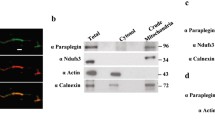Abstract
We have partially characterized four Drosophilamelanogaster alpha-actinin gene mutants,I(1)2Cb1, I(1)2Cb2,I(1)2Cb4, and I(1)2Cb5. Wedemonstrate that in each case the mutation is caused bya chromosomal rearrangement that precludes normal proteinsynthesis. In the absence of alpha-actinin, fliescomplete embryogenesis and develop into flaccid larvaethat die within approximately 24 hr. These larvae have noticeable muscle dysfunction at hatching,although they, nevertheless, are capable of escapingfrom the egg membranes and of subsequent crawlingmovements. During larval development muscles degenerate, progressively limiting mobility and ultimatelycausing death. Electron microscopy of mutant musclefibers reveals that myofibrils are grossly disrupted inone day old larvae and that electron-dense structures reminiscent of those seen in human nemalinemyopathies are present throughout larval life. Our workrigorously demonstrates that alpha-actinin deficienciesare the cause of I(1)2Cb muscle defects. We anticipate that the alpha-actinin mutants described hereinwill facilitate in vivo tests of spectrin superfamilyprotein domain functions using a combination of directedmutagenesis and germline transformation.
Similar content being viewed by others
REFERENCES
Davis, K. A., and Lux, S. E. (1989). Hereditary disorders of the red cell membrane skeleton. Trends Genet. 5:222.
Deatherage, J. F., Cheng, N., and Bullard, B. (1989). Arrangement of filaments and cross-links in the bee flight muscle Z-disk by image analysis of oblique sections. J. Cell Biol. 108:1175.
Ervasti, J. M., and Campbell, K. P. (1991). Membrane organization of the dystrophin-glycoprotein complex. Cell 66:1121.
Fyrberg, E., Kelly, M., Ball, E., Fyrberg, C., and Reedy, M. C. (1990). Molecular genetics of Drosophila alpha-actinin: Mutant alleles disrupt Z-disc integrity and muscle insertions. J. Cell Biol. 110:1999.
Hoffman, E. P., Brown, R. H., and Kunkel, L. M. (1987). Dystrophin: The protein product of the Duchenne muscular dystrophy locus. Cell 51:919.
Homyk, T., and Emerson, C. P., Jr. (1988). Functional interactions between unlinked muscle genes within haplo-insufficient regions of the Drosophila genome. Genetics 119:105.
Laing, N. G., Wilton, S. D., Akkari, P.A., Dorosz, S., Boundy, K., Kneebone, C., Blumberys, P., White, S., Watkins, H., Love, D. R., and Huan, E. (1995). A mutation in the α-tropomyosin gene TPM3 associated with autosomal dominant nemaline myopathy. Nature Genet. 9:75.
Lee, J. K., Coyne, R. S., Dubreuil, R. R., Goldstein, L. S. B., and Branton, D. (1993). Cell shape and interaction defects in α-spectrin mutants of Drosophila melanogaster. J. Cell Biol. 123:1797.
Masaki, T., Endo, M., and Ebashi, S. (1967). Localization of the 65 component of alpha-actinin at Z-band. J. Biochem. (Tokyo) 62:630.
Matsumoto, H., Isona, K., Pye, Q., and Park, W. L. (1987). Gene encoding cytoskeletal proteins in Drosophila rhabdomeres. Proc. Natl. Acad. Sci. USA 84:985.
Oro, A. E., McKeown, M., and Evans, R. M. (1990). Relationship between the product of the Drosophila ultraspiracle locus and the vertebrate retinoid × receptor. Nature 347:298.
Perrimon, N., Engstrom, L., and Mahowald, A. (1985). Developmental genetics of the 2C-D region of the Drosophila X-chromosome. Genetics 111:23.
Roulier, E. M., Fyrberg, C., and Fyrberg, E. (1992). Perturbations of Drosophila alpha-actinin cause muscle paralysis, weakness, and atrophy, but do not cause obvious nonmuscle phenotypes. J. Cell Biol. 116:911.
Sambrook, J., Fritsch, E. F., and Maniatis, T. (1989). Molecular Cloning, a Laboratory Manual, Cold Spring Harbor Laboratory Press, Cold Spring Harbor, NY.
Sanger, F., Nicklen, S., and Coulson, A. R. (1977). DNA sequencing with chain-terminating inhibitors. Proc. Natl. Acad. Sci. USA 74:5463.
Volk, T., Fessler, L. I., and Fessler, J. H. (1990). A role for integrin in the formation of sarcomeric architecture. Cell 63:525.
Yamaguchi, M., Robson, R. M., Stromer, M. H., and Oda, T. (1978). Actin filaments from the backbone of nemaline myopathy rods. Nature 271:265.
Rights and permissions
About this article
Cite this article
Fyrberg, C., Ketchum, A., Ball, E. et al. Characterization of Lethal Drosophila melanogaster alpha-Actinin Mutants. Biochem Genet 36, 299–310 (1998). https://doi.org/10.1023/A:1018789227987
Issue Date:
DOI: https://doi.org/10.1023/A:1018789227987




